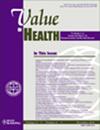Early Cost-Effectiveness Analysis of Using Whole-Genome Sequencing for Patients With Castration-Resistant Prostate Cancer
IF 4.9
2区 医学
Q1 ECONOMICS
引用次数: 0
Abstract
Objectives
This study aims to assess the potential cost-effectiveness of using whole-genome sequencing (WGS)-guided systemic therapy in metastatic castrate-resistant prostate cancer compared with the European Association of Urology guideline recommended diagnostics from a Dutch societal perspective.
Methods
A decision analytic model combining a decision tree and partitioned survival models was developed to link diagnostic results with subsequent biomarker-guided treatments. Two diagnostic strategies, WGS and guideline-recommended practice—the genomic testing for breast cancer gene 1/2 (BRCA1/2) and deficient mismatch repair, were simulated to compare the health outcome and cost. Treatment effectiveness was estimated through survival analysis using published trial data. Sensitivity and scenario analyses were conducted to examine result robustness and to identify conditions under which WGS may be cost-effective.
Results
WGS identified an additional 21% of patients eligible for personalized therapy (PD-1/PDL-1 inhibitors and olaparib), resulting in an incremental increase in cost (€14 260) and quality-adjusted life years (QALY = 0.05). These results yielded an incremental cost-effectiveness ratio of €289 625 per QALY gained. WGS would become cost-effective if the cost of biomarker-guided therapies decreases by 62% and when identifying a proportion of 23% more patients with actional targets.
Conclusions
Our findings suggest that future treatments with improved efficacy and reduced cost could potentially make the WGS strategy cost-effective. Its unaccounted potential value to identify prognostic biomarkers, diagnostic alternatives, and patient heterogeneity should be addressed in future research and considered for optimal implementation. New reimbursement options are needed considering the high prices of biomarker-guided therapies that drive the incremental cost-effectiveness ratio.
应用全基因组测序治疗去势抵抗性前列腺癌的早期成本-效果分析。
目的:本研究旨在评估使用全基因组测序(WGS)引导全身治疗转移性去势抵抗性前列腺癌(mCRPC)的潜在成本效益,并从荷兰社会的角度与欧洲泌尿外科协会指南推荐的诊断方法进行比较。方法:建立决策分析模型,结合决策树和分区生存模型,将诊断结果与随后的生物标志物指导治疗联系起来。模拟了两种诊断策略,WGS和指南推荐的做法- BRCA1/2和dMMR的基因组检测,以比较健康结果和成本。通过使用已发表的试验数据进行生存分析来估计治疗效果。进行敏感性和情景分析以检验结果的稳健性,并确定WGS可能具有成本效益的条件。结果:WGS确定了额外21%的患者符合个性化治疗(PD-1/PDL-1抑制剂和奥拉帕尼),导致成本(14,260欧元)和质量调整生命年(QALY = 0.05)的增量增加。这些结果产生的增量成本效益比(ICER)为289,625欧元/ QALY。如果生物标志物引导疗法的成本降低62%,并且能够识别出23%以上具有作用靶点的患者,那么WGS将具有成本效益。结论:我们的研究结果表明,未来的治疗方法可能会提高疗效和降低成本,使WGS策略具有成本效益。在确定预后生物标志物、诊断替代方案和患者异质性方面,其未被考虑的潜在价值应在未来的研究中得到解决,并考虑最佳实施。考虑到推动ICER的生物标志物引导疗法的高价格,需要新的报销选择。
本文章由计算机程序翻译,如有差异,请以英文原文为准。
求助全文
约1分钟内获得全文
求助全文
来源期刊

Value in Health
医学-卫生保健
CiteScore
6.90
自引率
6.70%
发文量
3064
审稿时长
3-8 weeks
期刊介绍:
Value in Health contains original research articles for pharmacoeconomics, health economics, and outcomes research (clinical, economic, and patient-reported outcomes/preference-based research), as well as conceptual and health policy articles that provide valuable information for health care decision-makers as well as the research community. As the official journal of ISPOR, Value in Health provides a forum for researchers, as well as health care decision-makers to translate outcomes research into health care decisions.
 求助内容:
求助内容: 应助结果提醒方式:
应助结果提醒方式:


